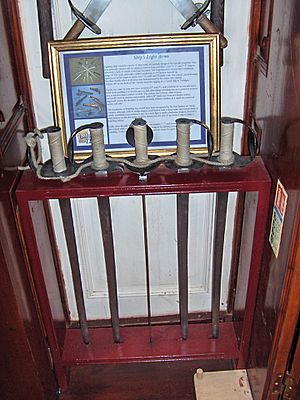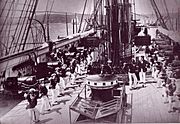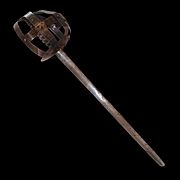Cutlass facts for kids
Quick facts for kids Cutlass |
|
|---|---|
 |
|
| Type | Sword (short sabre, single-edged) |
| Place of origin | Europe |
| Service history | |
| In service | 17th, 18th, 19th, and early 20th century |
| Used by | Sailors, pirates, and privateers |
| Specifications | |
| Length | Mostly 28-32 inches (leadcutter cutlasses were up to 36 inches in length). |
|
|
|
| Blade type | Single-edged |
| Hilt type | Cup hilted guards, half-basket cup guards, and branch guards were commonly seen with cylindrical hilts and wire-wrapped hilts which are common and found on most cutlasses. |
A cutlass is a short, wide sword with a single sharp edge. It often has a special guard shaped like a cup or basket to protect the hand. This type of sword was a very common weapon for sailors during the time of sailing ships.
Contents
What's in a Name? The Word "Cutlass"
The word "cutlass" comes from an old French word, "coutelas." This word meant a mid-sized, single-edged blade, a bit like a machete. In Italy, a similar sword was called a "cortelazo," meaning "large knife." Both words come from a Latin word, "cultellus," which means "smaller knife."
Today, in some parts of the English-speaking Caribbean, people still use the word "cutlass" to mean a machete.
History and Use of the Cutlass

Where Did the Cutlass Come From?
The cutlass developed from older short swords. These included the medieval falchion. In the 17th and 18th centuries, woodsmen and soldiers used similar short, wide swords. These were sometimes called a hanger or a messer (which means "knife" in German).
Around 1685 in England, longer, straight swords started to be replaced by the "hanger." This weapon had a shorter, often curved blade. It usually had a brass handle with a flat, double-shell guard. The blade was typically about 24 inches (61 cm) long.
Why Was the Cutlass So Popular?
The cutlass is most famous as the weapon of choice for sailors. It was popular for several reasons:
- Strong and Useful: It was tough enough to cut through thick ropes, heavy canvas sails, and dense plants.
- Good for Tight Spaces: Its short length made it perfect for fighting in small areas. This included ship boarding actions, climbing in the rigging, or fighting below decks.
- Easy to Learn: Using a cutlass effectively needed less training than a rapier or small sword. It was also better for close combat on a crowded ship than a full-sized sword.
Cutlasses are often linked with pirates. While pirates didn't invent them, they certainly used them a lot. Famous pirate crews, like those of William Fly, William Kidd, and Stede Bonnet, used cutlasses. The French historian Alexandre Exquemelin wrote that the buccaneer François l'Ollonais used a cutlass as early as 1667. Pirates used these weapons to scare people as much as to fight. Sometimes, just grabbing the handle was enough to make a crew surrender.
Because it was so useful, the cutlass was also a common farm tool. It was used in rain forests and sugarcane fields, especially in the Caribbean and Central America. In its simplest form, it became the machete we know today.
The lead cutter sword was a special type of cutlass. It was made for sword-fighting shows in the late Victorian era. These swords were used to cut a lead bar in half during demonstrations.
- Late naval examples
-
A cutlass drill on HMS Wolverine, 1882
The Cutlass in Modern Times
In 1830, police officers in London were given cutlasses for protection. They were first carried during night duty. Later, they were kept in offices for emergencies. Police forces outside London sometimes used cutlasses during public unrest. They would strike rioters with the flat side of the blade.
In 1936, the British Royal Navy announced that cutlasses would only be used for ceremonial duties. They would no longer be used in landing parties (groups of sailors going ashore). Some say the last time the Royal Navy used cutlasses in a real fight was on February 16, 1940. This was during the Altmark Incident, when a British ship boarded a German ship. However, many experts disagree with this idea. They believe the last use was by a shore party in China in 1900. Today, cutlasses are still worn by some Royal Navy officers during special ceremonies.
The cutlass was an official weapon in the United States Navy until 1949. It was not often used for training after the early 1930s. The last new model of cutlass for the US Navy was the US M1917 cutlass, used during World War I. A US Marine Combat Engineer is reported to have used a US M1941 cutlass in the Battle of Inchon during the Korean War. Today, a cutlass is still carried by a special recruit leader at the US Navy Recruit Training Command. Since 2011, US Navy Chief Petty Officers can also wear a ceremonial cutlass as part of their dress uniform.
See also
- Elgin pistol
- Chinese butterfly sword




